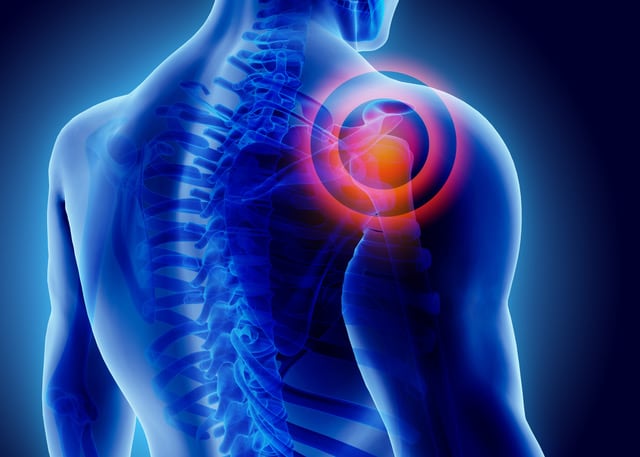The shoulder is the most mobile joint in the body and as a result it allows us to do many things at a high level including throwing, serving, swimming, reaching, pushing, pulling and heavy lifting. The bones in your shoulder include your arm (Humerus) which connects to the face of your shoulder blade (Scapula); this makes the “shoulder joint “. The upper outer part of your scapula (Acromion, the point of your shoulder) meets the outer end of the collarbone (Clavicle) and makes up a smaller joint above the shoulder called the “AC joint”. Connecting the bone structures are the ligaments that provide support and stability to the joints. On the scapula side there is an additional piece of tissue called the Labrum which is type of cartilage that also can provide some stability. On top of these structures live the muscles call the rotator cuff and the biceps tendon, which travel from the scapula underneath the collar bone and attach to the humerus.

Shoulder problems can be categorized into problems related to overuse; problems related to injury-trauma; and problems related to aging/wear and tear, also referred to as degeneration.
With injuries, often related to a fall, a person can fracture (break) a bone, or sometimes they can separate the collarbone from the acromion. Sometimes they can dislocate the shoulder, meaning the arm pops out of the socket. Many of these injuries can be treated without surgery, often with the use of a sling, modified activities, occasional x-rays to check on healing and eventually going to physical therapy. Some of these injuries require surgery if the bones are not well aligned or if the shoulder remains unstable and it’s felt that surgery would provide better long-term results. This is often the case in patients who dislocate their shoulders repeatedly. A surgical procedure called arthroscopy of the shoulder, which involves making small incisions and placing a camera to visualize the ligaments and cartilage of the shoulder, can be performed to repair these tissues and tighten the shoulder, to make it stable and prevent repeated dislocations.
Other forms of injury can occur to the soft tissues call the rotator cuff. These are 4 muscles that provide strength and stability to the shoulder. Pain related to the rotator cuff is often called tendinitis , bursitis or impingement syndrome and can occur from repetitive use over time or some friction against bone spurs from arthritis. Some rotator cuff tears can developed from repeated stress or from an injury. Some rotator cuff tears can heal or simply stop hurting with rest and physical therapy, whereas others are better off undergoing a similar type of arthroscopic surgical procedure to repair the tendons back to the bone. This allows patients pain relief and better recovery of shoulder strength and function.
Some shoulder problems related to aging, wear and tear, also called degeneration. This can involve the soft tissues such as the rotator cuff and biceps tendon. Sometimes these tissues just wear down as we get older, it is a natural process but they become more susceptible tip pain from overuse. Often times these conditions respond to rest, physical therapy, some anti-inflammatory medication and very careful selective use of a cortisone injection. Surgery also can be performed for lack of improvement. Other types of wear and tear problems occur as a result of arthritis in the shoulder. Arthritis in the shoulder generally occurs as the hard cartilage covering the bone, which normally protects it, starts to wear thin. The bone becomes exposed to higher stresses. This can lead to pain, stiffness, noisy shoulders and decreased function. Arthritis can also be managed with medications, therapy, injections but if it becomes severe enough he can be managed with a different type of surgery called a total shoulder replacement. Much like replacing the joints of the hips and the knees, a shoulder replacement can provide dramatic pain relief.
Regardless of whether not you have had an injury, or have just started experiencing pain related to overuse, if your shoulder is hurting, there are many options available for treatment. It is important to visit with your orthopaedic surgeon so that you can have a thorough assessment of your pain including a physical examination and an x-ray of the shoulder.
